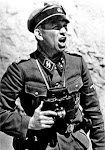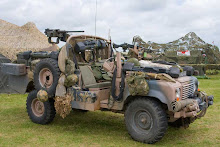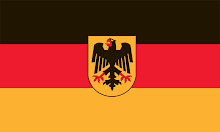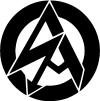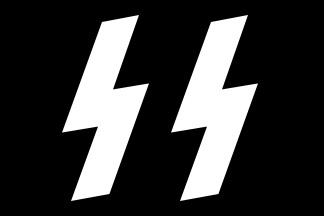The modern German army the bundeswhers insignia! ( Bundeswher =Fedral defense force)
Sunday, January 24, 2010
Saturday, January 23, 2010
Ost Deutschland
Wednesday, January 13, 2010
Sunday, January 10, 2010
Volksstrum
The Volkssturm or peoples national Militia was a German national Militia of the last monthes of WWII. It was founded on Hitlers orders on October 18, 1944 to conscript males between the ages of 16 and 60 years old who were not already serving in some millitary unit as part of the German home guard.
Plans to form a Landsturm national militia in Eastern Germany as a last resort to boost fighting strength initially came from Oberkommando des Heeres chief General Heinz Guderian in 1944. Because the Wehrmacht was lacking manpower to stop the Soviet advance, men in jobs not deemed necessary or previously deemed unfit for military service were now called under arms. The Volkssturm had existed, on paper, since approximately 1925, however it was only after Hitler ordered Martin Bormann to recruit six million men for this militia that the group became a physical reality. The intended strength of six million was never attained.
Typically, members of the Volkssturm received only very basic military training. It included a brief indoctrination and training on the use of basic weapons such as the Karabiner 98k rifle and Panzerfaust. Because of continuous fighting and weapon shortages, weapon training was often very minimal. There was also a lack of instructors, meaning that weapons training was sometimes done by WW1-veterans drafted into service themselves. Often Volkssturm members had to familiarize with their weapons when in actual combat
There was no standardization of any kind and units were issued only what equipment was available. This was true of every form of equipment—Volkssturm members were required to bring their own uniforms and culinary equipment etc. This resulted in the units looking very ragged and, instead of boosting civilian morale, it often reminded people of the Germany's desperate state. Armament was equally diverse, while some Karabiner 98ks were on hand, members were also issued Gewehr 98s and Gewehr 71s in addition to a plethora of Soviet, Belgian, French, Italian and other weapons that had been captured by German forces during the war. The Germans had also developed primitive cheap weapons to supply the Volkssturm, like MP 3008 machine pistols and the Volkssturmgewehr 1-5 submachine rifle. Being armed with leftovers compounded their ineffectiveness; the large number of different ammunition types also put a strain on an already burdened logistics system. also thanks McCoy for giving me that info on the Volkssturmgewehr 1-5.
When units had completed their training and received armament, members took a customary oath to Hitler and were then dispatched into combat.Germany had universal military service for all young men for several generations, so many of the older members would have had at least basic military training when they served in the German Army and, as noted before, many would have been veterans of the First World War. Volkssturm units were supposed to be used only in their own districts, but many were sent directly to the front lines. Their most extensive use was during the Battle of Berlin, during which Volkssturm units fought in many parts of the city. This battle was particularly devastating to its formations, however, since many members fought to the death out of fear of being captured by the Soviets. Another important Volkssturm battle was the Battle of Königsberg.
The VS were some of the bravest men ever to love they gave their lives in a call to arms and they defended Deutschland to the last drop of blood we shall never forget them!!!!
Saturday, January 9, 2010
Wednesday, January 6, 2010
Saturday, December 12, 2009
13th Waffen Mountain Division of the SS Handschar (1st Croatian)
History.
After the fall of Sarajevo on 16 April 1941 to Nazi Germany, the extremist Croat-nationalist and Fascist Ante Pavelić (who had been in exile in Mussolini's Italy) was appointed Poglavnik or leader of a new Ustaše state - Nezavisna Država Hrvatska (NDH, the Independent State of Croatia). The Yugoslav provinces of Croatia, Bosnia-Herzegovina and parts of Serbia were reconstituted as a pro-Nazi satellite entity under joint Nazi and Italian occupation. The Ustaše almost immediately launched a vicious campaign of violence directed at unarmed Serb civilians.
On 6 July 1941 Pavelić's Culture and Education Minister, Mile Budak, announced that the Ustaše considered the Bosnian Muslims an integral part of the NDH : "The Croatian State is Christian. It is also a Muslim State where our people are of the Islamic religion." Pavelić ordered a property in Zagreb be converted into a mosque that he modestly named after himself in his efforts to secure the loyalty of the Bosnian Muslims : the Poglavniks Mosque.[1]
Bosnian Muslim clerics issued three declarations (fatāwa), all publicly denouncing Croat-Nazi collaborationist measures, laws and violence against Jews and Serbs: that of Sarajevo in October 1941, of Mostar in 1941, and of Banja Luka on 12 November 1941 [2].
Despite Pavelić's assurances of equality, it wasn't long before many Bosniaks became dissatisfied with Croatian rule. An Islamic leader reported that not one Muslim occupied an influential post in the (local) administration. Fierce fighting broke out between Ustase and Partisans. A number of Ustase units believed that the Bosniaks were communist sympathizers and burned their villages and murdered civilians. Serb victims of the violence were inclined to view the Bosniaks as collaborators.
The Fall of 1942 saw SS Reichsfuhrer Heinrich Himmler and SS-General Gottlob Berger approach Hitler with the proposal to raise a Bosnian Muslim SS division. Both the Wehrmacht and the SS were concerned about the rapidly deteriorating security situation in the NDH that tied down German military personnel that could be better employed elsewhere. By the New Year of 1943 over 100,000 Bosnian Muslims had been killed (9% of all Bosniaks at the time) and 250,000 had been expelled from their homes - mostly by Serb Chetniks. "The Muslims" remarked one German General, "bear the special status of being persecuted by all others".[3]
Himmler fantasized that there was a fanatical, blind obedience in the Bosniaks. He thought that Muslim men would make perfect SS soldiers as Islam "promises them Heaven if they fight and are killed in action."[4] Himmler was also inspired by the noted successes of Hapsburg Bosnian infantry regiments in World War I.
George Lepre wrote : "Himmler endeavoured to restore what he called 'an old Austrian' tradition by reviving the Bosnian regiments of the former Austro-Hungarian army in the form of a Bosnian Muslim SS Division. Once raised, this division was to engage and destroy Tito's Partisan forces operating in North-eastern Bosnia, thus restoring local 'order'. To be sure, Himmler's primary concern in the region was not the security of the local Muslim population, but the welfare of ethnic German settlers to the north in Srem. 'Srem is the breadbasket of Croatia, and hopefully it and our beloved German settlements will be secured. I hope that the area south of Srem will be liberated by ... the Bosnian division ... so that we can at least restore partial order in this ridiculous (Croatian) state.' [5]
Hitler formally approved the project on 10 February 1943 and SS-Obergruppenführer Arthur Phleps, a Romanian ethnic German commander, was charged with raising the division.
After the fall of Sarajevo on 16 April 1941 to Nazi Germany, the extremist Croat-nationalist and Fascist Ante Pavelić (who had been in exile in Mussolini's Italy) was appointed Poglavnik or leader of a new Ustaše state - Nezavisna Država Hrvatska (NDH, the Independent State of Croatia). The Yugoslav provinces of Croatia, Bosnia-Herzegovina and parts of Serbia were reconstituted as a pro-Nazi satellite entity under joint Nazi and Italian occupation. The Ustaše almost immediately launched a vicious campaign of violence directed at unarmed Serb civilians.
On 6 July 1941 Pavelić's Culture and Education Minister, Mile Budak, announced that the Ustaše considered the Bosnian Muslims an integral part of the NDH : "The Croatian State is Christian. It is also a Muslim State where our people are of the Islamic religion." Pavelić ordered a property in Zagreb be converted into a mosque that he modestly named after himself in his efforts to secure the loyalty of the Bosnian Muslims : the Poglavniks Mosque.[1]
Bosnian Muslim clerics issued three declarations (fatāwa), all publicly denouncing Croat-Nazi collaborationist measures, laws and violence against Jews and Serbs: that of Sarajevo in October 1941, of Mostar in 1941, and of Banja Luka on 12 November 1941 [2].
Despite Pavelić's assurances of equality, it wasn't long before many Bosniaks became dissatisfied with Croatian rule. An Islamic leader reported that not one Muslim occupied an influential post in the (local) administration. Fierce fighting broke out between Ustase and Partisans. A number of Ustase units believed that the Bosniaks were communist sympathizers and burned their villages and murdered civilians. Serb victims of the violence were inclined to view the Bosniaks as collaborators.
The Fall of 1942 saw SS Reichsfuhrer Heinrich Himmler and SS-General Gottlob Berger approach Hitler with the proposal to raise a Bosnian Muslim SS division. Both the Wehrmacht and the SS were concerned about the rapidly deteriorating security situation in the NDH that tied down German military personnel that could be better employed elsewhere. By the New Year of 1943 over 100,000 Bosnian Muslims had been killed (9% of all Bosniaks at the time) and 250,000 had been expelled from their homes - mostly by Serb Chetniks. "The Muslims" remarked one German General, "bear the special status of being persecuted by all others".[3]
Himmler fantasized that there was a fanatical, blind obedience in the Bosniaks. He thought that Muslim men would make perfect SS soldiers as Islam "promises them Heaven if they fight and are killed in action."[4] Himmler was also inspired by the noted successes of Hapsburg Bosnian infantry regiments in World War I.
George Lepre wrote : "Himmler endeavoured to restore what he called 'an old Austrian' tradition by reviving the Bosnian regiments of the former Austro-Hungarian army in the form of a Bosnian Muslim SS Division. Once raised, this division was to engage and destroy Tito's Partisan forces operating in North-eastern Bosnia, thus restoring local 'order'. To be sure, Himmler's primary concern in the region was not the security of the local Muslim population, but the welfare of ethnic German settlers to the north in Srem. 'Srem is the breadbasket of Croatia, and hopefully it and our beloved German settlements will be secured. I hope that the area south of Srem will be liberated by ... the Bosnian division ... so that we can at least restore partial order in this ridiculous (Croatian) state.' [5]
Hitler formally approved the project on 10 February 1943 and SS-Obergruppenführer Arthur Phleps, a Romanian ethnic German commander, was charged with raising the division.
Saturday, November 28, 2009
AWSOME GAMES !!!!!!!!!!!!!!
http://www.addictinggames.com/worldwars2.html
http://www.addictinggames.com/warfare1944.html
http://www.addictinggames.com/warfare1917.html
http://www.addictinggames.com/tanks.html
http://www.miniclip.com/games/commando-2/en/
http://www.miniclip.com/games/fighter-pilot/en/
http://www.miniclip.com/games/under-arms/en/
http://www.miniclip.com/games/hostile-skies/en/
http://www.miniclip.com/games/skies-of-war/en/
http://www.addictinggames.com/warfare1944.html
http://www.addictinggames.com/warfare1917.html
http://www.addictinggames.com/tanks.html
http://www.miniclip.com/games/commando-2/en/
http://www.miniclip.com/games/fighter-pilot/en/
http://www.miniclip.com/games/under-arms/en/
http://www.miniclip.com/games/hostile-skies/en/
http://www.miniclip.com/games/skies-of-war/en/
Canadians
I cant belive this we have hundreds of canadians being fired and layed off because cheap labour can be imported from mexico and china they need to buy canadian and become a soverngn nation agian.
Friday, November 27, 2009
Panzer Song Lyrics
First stanza
Ob's stürmt oder schneit, ob die Sonne uns lacht,
Der Tag glühend heiß, oder eiskalt die Nacht,
Bestaubt sind die Gesichter, doch froh ist unser Sinn,
Ja, unser Sinn,
Es braust unser Panzer im Sturmwind dahin.
English
Whether it storms or snows, whether the sun smiles upon us,
The day scorching hot, or the night freezing cold.
Dusty are our faces, but our minds are joyful,
Yes, our minds
Our Panzer rushes past in the stormwind.
Second stanza
Wenn vor uns ein feindlicher Panzer erscheint,
Wird Vollgas gegeben und ran an den Feind.
Was gilt denn unser Leben für uns'res Reiches Heer?
Ja, Reiches Heer?
Für Deutschland zu sterben ist uns höchste Ehr'.
English:
When before us a hostile tank appears,
Full throttle is given and we close in on the enemy.
What really does our life matter for our nations army?
Yes, our nations army?
To die for Germany is our highest honour.
Third stanza
Mit donnerndem Motor, geschwind wie der Blitz,
Dem Feinde entgegen, im Panzer geschützt
Voraus den Kameraden, im Kampf steh'n wir allein,
Steh'n wir allein,
So stoßen wir tief in die feindlichen Reih'n.
English:
With thundering engines, fast as the lightning,
Towards the enemy, by our Panzer protected.
Ahead of our comrades, in battle we stand alone,
We stand alone,
That's how we thrust deep into the enemy ranks.
Fourth stanza
Mit Sperren und Minen hält der Gegner uns auf,
Wir lachen darüber und fahren nicht drauf.
Und droh'n vor uns Geschütze, versteckt im gelben Sand,
Im gelben Sand,
Wir suchen uns Wege, die keiner sonst fand.
English:
With barriers and mines the foe blocks our path,
We laugh about them and don't drive upon them.
And if cannons threaten before us, hidden in the yellow sand,
In the yellow sand,
We find ourselves pathways, that no one else has found.
Fifth stanza
Und läßt uns im Stich einst das treulose Glück,
Und kehr'n wir nicht mehr zur Heimat zurück,
Trifft uns die Todeskugel, ruft uns das Schicksal ab,
Ja, Schicksal ab,
Dann wird uns der Panzer ein ehernes Grab.
English:
And are we once deserted by disloyal luck,
And we don't return to our home any more,
A bullet of death hits us, fate calls upon us,
Yes, fate upon us,
Then our panzer will be an iron grave!
Ob's stürmt oder schneit, ob die Sonne uns lacht,
Der Tag glühend heiß, oder eiskalt die Nacht,
Bestaubt sind die Gesichter, doch froh ist unser Sinn,
Ja, unser Sinn,
Es braust unser Panzer im Sturmwind dahin.
English
Whether it storms or snows, whether the sun smiles upon us,
The day scorching hot, or the night freezing cold.
Dusty are our faces, but our minds are joyful,
Yes, our minds
Our Panzer rushes past in the stormwind.
Second stanza
Wenn vor uns ein feindlicher Panzer erscheint,
Wird Vollgas gegeben und ran an den Feind.
Was gilt denn unser Leben für uns'res Reiches Heer?
Ja, Reiches Heer?
Für Deutschland zu sterben ist uns höchste Ehr'.
English:
When before us a hostile tank appears,
Full throttle is given and we close in on the enemy.
What really does our life matter for our nations army?
Yes, our nations army?
To die for Germany is our highest honour.
Third stanza
Mit donnerndem Motor, geschwind wie der Blitz,
Dem Feinde entgegen, im Panzer geschützt
Voraus den Kameraden, im Kampf steh'n wir allein,
Steh'n wir allein,
So stoßen wir tief in die feindlichen Reih'n.
English:
With thundering engines, fast as the lightning,
Towards the enemy, by our Panzer protected.
Ahead of our comrades, in battle we stand alone,
We stand alone,
That's how we thrust deep into the enemy ranks.
Fourth stanza
Mit Sperren und Minen hält der Gegner uns auf,
Wir lachen darüber und fahren nicht drauf.
Und droh'n vor uns Geschütze, versteckt im gelben Sand,
Im gelben Sand,
Wir suchen uns Wege, die keiner sonst fand.
English:
With barriers and mines the foe blocks our path,
We laugh about them and don't drive upon them.
And if cannons threaten before us, hidden in the yellow sand,
In the yellow sand,
We find ourselves pathways, that no one else has found.
Fifth stanza
Und läßt uns im Stich einst das treulose Glück,
Und kehr'n wir nicht mehr zur Heimat zurück,
Trifft uns die Todeskugel, ruft uns das Schicksal ab,
Ja, Schicksal ab,
Dann wird uns der Panzer ein ehernes Grab.
English:
And are we once deserted by disloyal luck,
And we don't return to our home any more,
A bullet of death hits us, fate calls upon us,
Yes, fate upon us,
Then our panzer will be an iron grave!
Waffen SS
The waffen ss where not war criminals the waffen ss or "armed" ss where elite combat soldgers not concontration camp guards
Subscribe to:
Posts (Atom)
